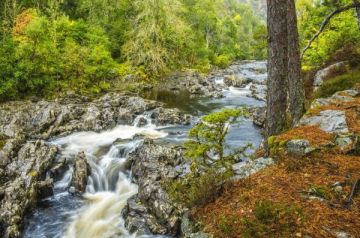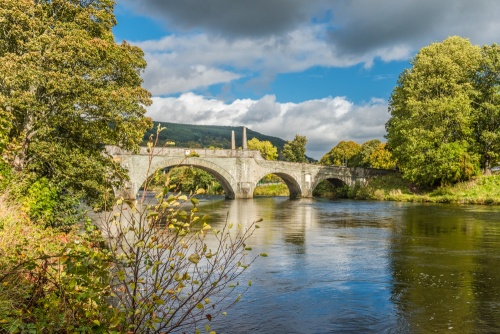
In 1725 Lieutenant-General George Wade was appointed Commander in Chief of His Majesty's Forces in North Britain. Wade was charged with building a network of roads and bridges throughout the Scottish Highlands to aid the transport of men and equipment.
King George II's government was rightly concerned about the possibility of another Jacobite uprising following the 1715 rebellion and wanted to make sure that military transport was as efficient as possible in case of another revolt.
Over the next 15 years, Wade oversaw the building of 250 miles of roads - the first engineered roads in Britain since the departure of the Romans in the early 5th century. To link those roads he also built over 40 bridges.
The most impressive 'Wade bridge' spanned the River Tay at what is now Aberfeldy. At the time it was the only bridge across the Tay, allowing access to the central and eastern Highlands from the south. It is sometimes known as the Tay Bridge.
The humpbacked bridge was designed by the famous Scottish architect William Adam, father of Robert Adam who went on to become perhaps the foremost country house architect in Britain. General Wade considered the elder Adam 'the best architect in Scotland'.
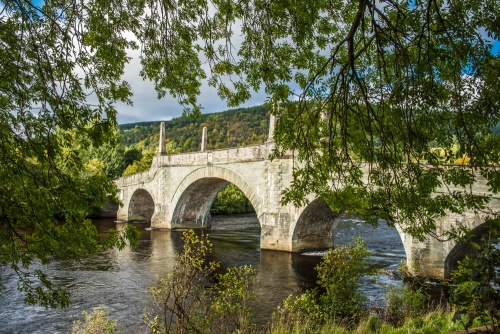
Adam's design was much more than a purely functional piece of military architecture; he created a neo-classical five-arched bridge stretching 112m (368 feet), with a central span of 18.2m (60 feet). Adam added Baroque details, including four obelisks over the central span and decorative pyramids at each end. The central span also has a raised parapet. The roadway is 14 feet wide.
To ease the impact of water on the bridge piers there are triangular cutwaters. The arches are segmental, and the bridge is composed of grey chlorite schist with rubble spandrels and arch rings of dressed stone. The piers were supported by 1200 timber piles encased in with iron sunk into the river bed.
On the inner face of the parapet in the centre of the bridge is a dedication panel in Latin which translates as:
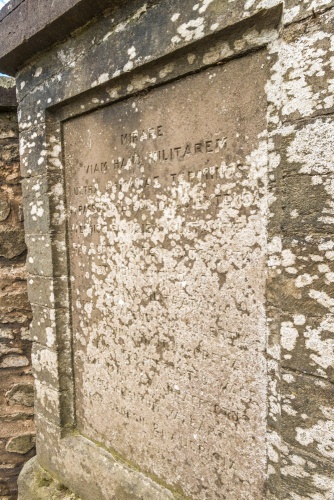
Admire this military road stretching on this
side and that 250 miles beyond the limits of the
Roman one, mocking moors and bogs, opened
up through rocks and over mountains, and, as
you see, crossing the indignant Tay. This
diffIcult work G. Wade, Commander-in-Chief of
the Forces in Scotland, accomplished by his own
skill and ten years labour of his soldiers in the
year of the Christian Era, 1733. Behold how
much avail the Royal auspices of George 2nd.
There is a second, smaller, panel on the exterior face of an arch at the east end of the bridge. It bears an inscription reading:
At the command of His Majesty King George
the 2nd this bridge was erected in the year 1733:
this with the roads and other military works for
securing a safe and easy communication
between the high lands and the tradeing towns
of the low country was by His Majesty
committed to the care of General George Wade,
Commander-in-Chief of the Forces in Scotland
who laid the first stone of this bridge on 23rd
April and finished the work in the same year.
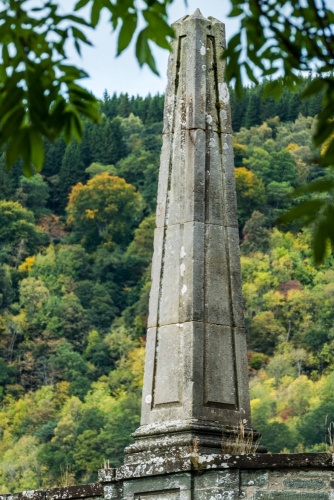
The exterior of the central arch bears another panel with relief carvings of a crown and crossed swords and the monogram of George II between them.
General Wade laid the foundation stone on 23 April 1733, though the bridge was not actually built until the following summer. The project was beset with delays, a fact that Wade blamed partly on the local Justices of the Peace who were slow to provide carriages to transport the quarried stone.
Stone was quarried at Farrowchil, a mile away. Skilled masons were brought from all across the north of England and they worked on finishing the blocks through the winter so that it could be quickly assembled in the summer. It was opened to traffic in October 1734, though the official opening ceremony did not take place until the summer of 1735.
The bridge cost a total of 4095 pounds (another source puts the cost at 3,596 pounds) and Wade considered it his finest achievement.
The building of Wade's Bridge was directly responsible for the town of Aberfeldy. At the time it was the only road bridge across the Tay, so it formed a vital link in transport routes. A settlement grew up near the east end of the bridge and in very short order grew to a considerable size.
Wade considered his network of roads and bridges an essential step in keeping peace in the turbulent Highlands. However, the only military commander to actually benefit directly was Bonnie Prince Charlie, whose Jacobite troops used the road network to their advantage during the 1745 Rebellion.

Bonnie Prince Charlie himself crossed the bridge in February 1746 on his retreat north from the failure of his invasion of England. He stayed at Castle Menzies, just a mile away, for two days. Just two days after that a contingent of the Duke of Cumberland's soldiers followed him across the bridge. They would eventually catch up with the Prince and his men at the Battle of Culloden near Inverness, a battle that effectively ended Jacobite hopes.
Though many of General Wade's military roads are still in use today, the bridge in Aberfeldy is the only one of Wade's bridges still in daily use. Today it carries the B846 over the River Tay. It was not designed to carry two lanes of traffic so there are lights at each end to regulate traffic flow.
Directly beside the east end of the bridge is the iconic Black Watch Memorial, erected in 1887 to mark Queen Victoria's Golden Jubilee. It commemorates the first muster of the Black Watch Regiment (42nd Royal Highlanders), which took place in a field on the north bank of the river, opposite the memorial.
The bridge is very easy to reach on foot from central Aberfeldy and there are several pedestrian signposts pointing the way. Alternatively, there is usually parking available on Taybridge Drive immediately south-east of the bridge. You can also easily walk across the bridge.
Related:
See our article on another of General Wade's bridges in Whitebridge, on the south-eastern shore of Loch Ness.
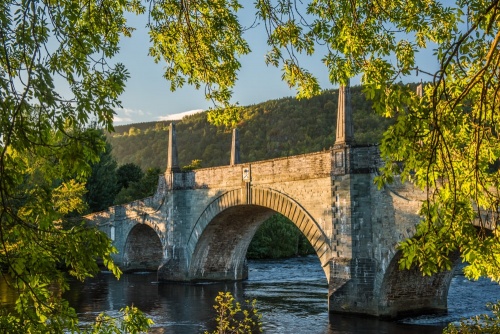
About General Wade's Bridge, Aberfeldy
Address: Taybridge Road, B846, Aberfeldy,
Perthshire,
Scotland
Attraction Type: Historic Building - Bridge
Location: At the western end of Taybridge Road (B846). Easy access from the town centre.
Website: General Wade's Bridge, Aberfeldy
Location map
OS: NN851493
Photo Credit: David Ross and Britain Express
HERITAGE
 We've 'tagged' this attraction information to help you find related historic attractions and learn more about major time periods mentioned.
We've 'tagged' this attraction information to help you find related historic attractions and learn more about major time periods mentioned.
Find other attractions tagged with:
NEARBY HISTORIC ATTRACTIONS
Heritage Rated from 1- 5 (low to exceptional) on historic interest
Black Watch Memorial - 0 miles (Historic Building) ![]()
Aberfeldy, St Andrew's Church - 0.2 miles (Historic Church) ![]()
Aberfeldy Water Mill - 0.3 miles (Museum) ![]()
Moness Cup-Marked Stone - 0.5 miles (Prehistoric Site) ![]()
Birks of Aberfeldy - 0.5 miles (Countryside) ![]()
Old Kirk of Weem - 0.6 miles (Historic Church) ![]()
Weem Forest & St David's Well - 0.7 miles (Countryside) ![]()
Castle Menzies - 1.1 miles (Historic House) ![]()
Nearest Holiday Cottages to General Wade's Bridge, Aberfeldy:
More self catering near General Wade's Bridge, Aberfeldy



